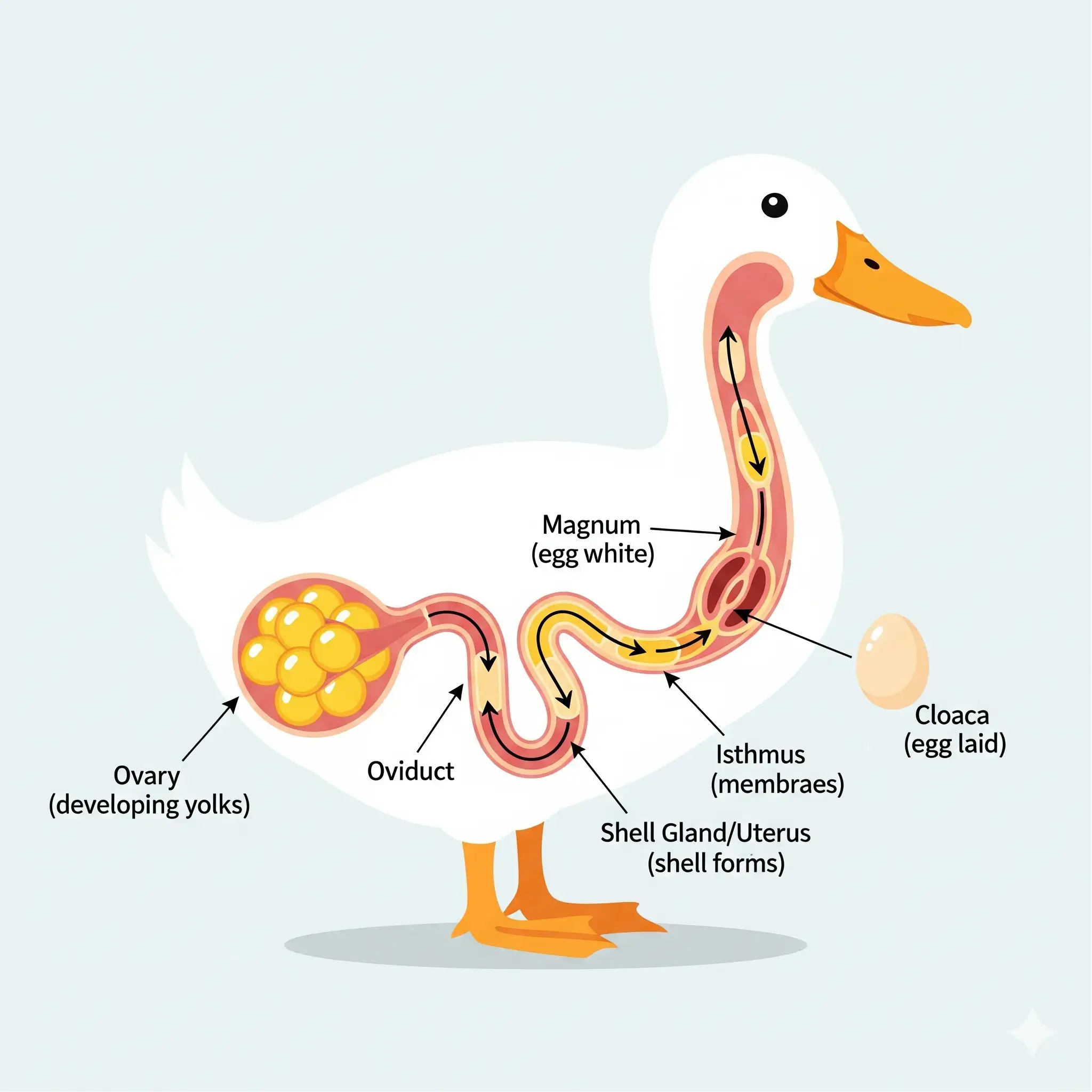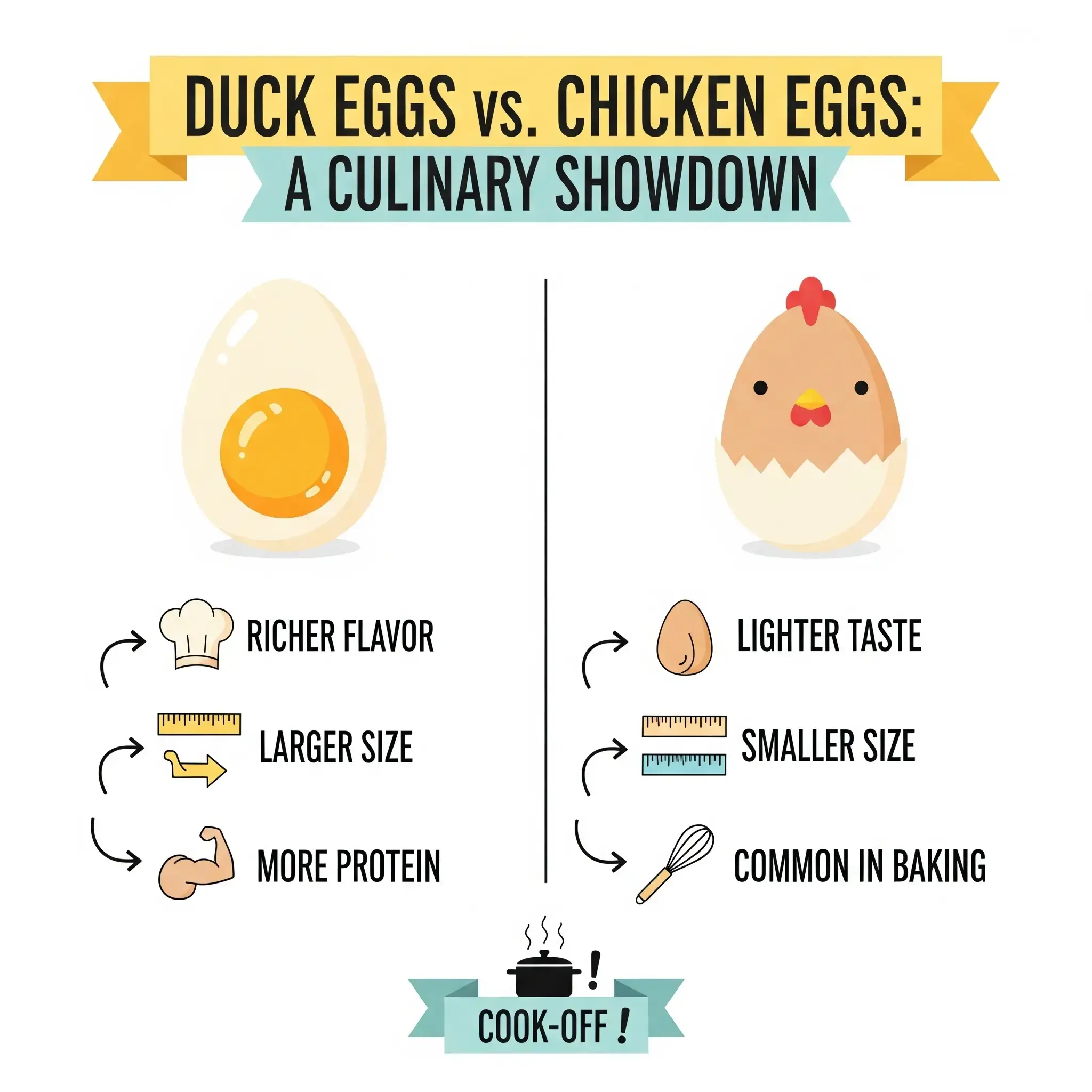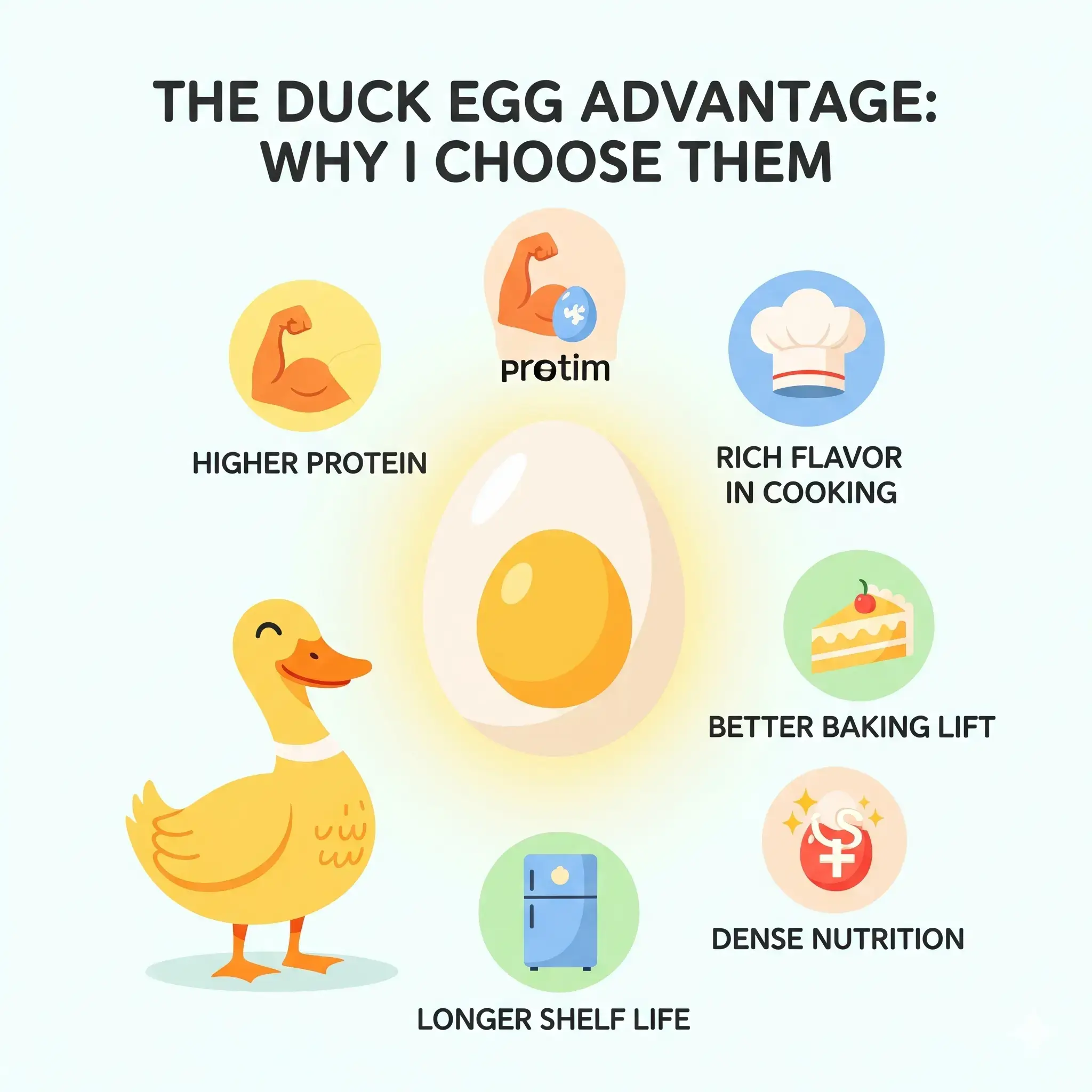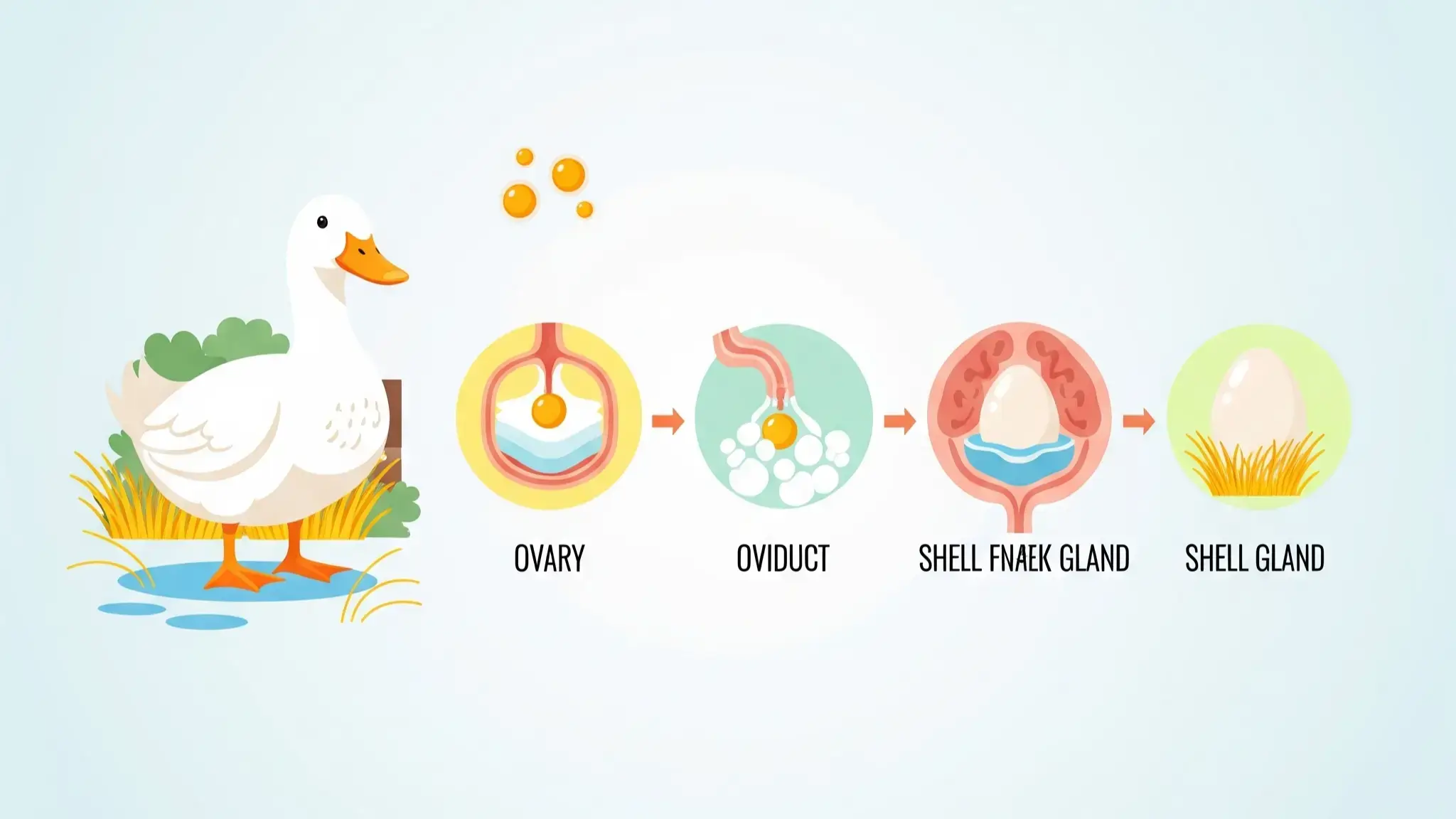Have you ever cracked open a duck egg and wondered about its journey? I certainly have, especially with my own backyard flock of feathered friends. It’s a fascinating process, far more intricate than just a chicken laying an egg.
Today, I’m going to pull back the curtain and share the incredible science and personal observations behind how these beautiful duck eggs are made, from the first flicker of life to your kitchen.
The Inner Workings: A Glimpse into the Duck’s Reproductive System

It all begins deep inside the duck. Just like us, ducks have a sophisticated reproductive system. For a duck to lay an egg, her body orchestrates a daily marvel.
From Ovary to Ova: The Birth of a Yolk
Imagine a cluster of tiny, potential yolks – that’s the ovary at work. This is where yolk development really kicks off. Each yolk starts as a tiny cell, or ova, and through a process called follicle growth, it gathers nutrients, growing larger and larger.
Here’s a cool fact: if you look closely at a boiled egg yolk, you might spot dark rings and light layers. These are like growth rings on a tree, showing the daily deposits of fat and protein. These nutritional factors are crucial for the developing embryo if the egg is fertilized.
The Oviduct Journey: A Chamber-by-Chamber Transformation
Once a yolk reaches its full size – about 24 hours – it’s released from the ovary. This is called yolk release. It then embarks on an amazing journey down the oviduct. Think of the oviduct as a specialized assembly line with different oviduct chambers, each with a vital role.
- Infundibulum: The Catch-All Funnel: The yolk is caught by the infundibulum, a funnel-like structure. If a drake (male duck) is around, this is where the fertilization process might occur.
- Magnum Formation: Building the Egg White: Next up is the magnum formation. This is the longest section, and it’s where the albumen, or egg white, is added. This protein composition is incredible, rich in protein, minerals, and water. I always marvel at the sheer volume of egg white in a duck egg compared to a chicken egg!
- Isthmus Development: Crafting the Shell Membranes: After the magnum, the egg moves into the isthmus development. Here, the shell membranes are formed – those two thin layers you see just inside the shell. They’re vital for protecting the inner contents and form the air cell at the blunt end of the egg. This air cell grows larger as the egg ages, allowing for crucial gas exchange.
- Shell Gland (Uterus): The Hardening Stage: The final major stop before laying is the shell gland, also known as the uterus. This is where the magic of the shell happens! Tiny calcite crystals of calcium carbonate are deposited around the membranes, slowly building up the hard outer layer. This process, lasting around 20 hours, gives the duck egg its impressive shell strength. The duck’s diet plays a huge role here; good dietary influence means strong shells!
The Final Stretch: Cloaca Passage and Laying
Once the shell is complete and often coated with a cuticle protection or protective bloom (a natural, invisible layer that prevents bacteria from entering), the egg is ready.
Through a series of muscular contractions and contractions within the vaginal passage and cloaca passage, the duck expels the egg. This entire production cycle from yolk release to oviposition mechanics takes about 25 hours. What a daily cycle!
The Laying Stages: From Nesting to Hatching
A duck’s laying stages are influenced by many things, including environmental conditions and their breed.
Broodiness and Nesting Behavior
When a duck becomes broody, she’s ready to sit on a clutch of eggs to hatch them. It’s a powerful instinct! I’ve seen my ducks spend hours meticulously arranging their nests, a clear sign of nesting behavior.
This brood behavior is essential for successful incubation. During this time, she’ll maintain the perfect temperature for the developing ducklings.
Hatchability and Lifecycle
Not all eggs are destined to become ducklings. Hatchability depends on many factors, including the fertilization process, proper incubation, and the shell quality. If all goes well, after about 28 days of incubation, tiny ducklings emerge, ready to begin their own lifespan.
The cycle continues as they grow and eventually, through good flock management and proper nutrient conversion, begin their own egg laying peak.
Duck Eggs vs. Chicken Eggs: A Culinary Showdown

While I adore chicken eggs, duck eggs are a whole different ballgame in the kitchen.
| Feature | Duck Egg | Chicken Egg |
| Size | Generally larger | Standard size |
| Yolk Size | Larger yolk | Smaller yolk |
| Protein Density | Higher protein density | Standard protein density |
| Flavor Profile | Richer, bolder, more robust flavor | Milder, more neutral |
| Baking Quality | Superior for extraordinary baked goods | Good for everyday baking |
I’ve found their culinary value is unmatched, especially in baking qualities. The extra albumen and fat make for incredibly rich custards, light fluffy cakes, and decadent ice cream. They’re fantastic for omelet preparation, and even make salad dressing ingredients sing.
Nutritional Punch: A Powerhouse of Goodness
Beyond taste, duck eggs pack a serious nutritional punch. They generally have:
- Higher cholesterol content (but studies show dietary cholesterol has less impact on blood cholesterol for most people).
- Slightly higher calorie intake.
- More vitamins and minerals, including omega-3 fatty acids, vitamin D, and a significant amount of vitamin B12 (essential for red blood cells, DNA synthesis, and nerve function).
- Excellent source of antioxidants.
For those with food allergy or sensitivity to chicken eggs, duck eggs can sometimes be an allergy friendly alternative.
However, always consult a doctor if you suspect an immune response or intolerance leading to stomach cramps, digestion issues, or vomiting reaction.
From Coop to Kitchen: Egg Care and Storage
Ensuring the longevity and deliciousness of your duck eggs involves proper egg collection and egg storage.
Egg Care and Cleaning
Because of their porous structure and the natural bloom, dirty eggs can happen, especially with free ranging ducks. I always make sure to clean them gently without scrubbing off the bloom unless I’m using them right away.
This cuticle protection helps prevent bacteria from entering through the shell pores and minimizes odor absorption, which can affect taste variation over time. Proper flock habits and a clean duck house help immensely.
Storage Impact and Lifespan
Duck eggs generally have a longer lifespan in the fridge than chicken eggs, often lasting up to six weeks due to their thicker shell and bloom. However, their porous structure means they can absorb odours if stored near strong-smelling foods, which can lead to deterioration of taste.
Sustainable Production: Backyard Flocks and Beyond
Raising a backyard flocks of ducks for sustainable production of eggs is one of my greatest joys. It promotes flock sustainability and flock wellness.
Productivity and Seasonal Output
Duck breeds like the Cayuga and Aylesbury are excellent layers. Their laying cycle can be influenced by light and cold weather, sometimes leading to seasonal output changes or even dormancy in the depths of winter.
However, with good flock management, including proper nutrition intake and feed reliance, my ducks remain quite productive.
Managing Egg Size and Kitchen Versatility
While the larger size and larger yolk of duck eggs are a boon, they can present a serving challenge for some recipes. However, their kitchen versatility more than makes up for it.
From scrambled mixture to frying texture (though be careful not to make them too rubbery!), they’re a delight. Their creamy texture and robust flavor are a chefs preference for a reason!
The Duck Egg Advantage: Why I Choose Them

For me, the pros of duck eggs far outweigh any cons. They offer a fantastic nutritional punch for household nutrition, contributing to heart health with their monounsaturated fats and polyunsaturated fats. My ducks are more cold-hardy than chickens, showing good winter hardiness, and require less specialized farm management.
From yolk-to-white ratio to the incredible shell design, every aspect of egg formation is a testament to avian physiology. They truly offer a unique culinary experience that enhances my daily cooking and keeps my pantry stocking full of these golden treasures.
FAQs
Q: What exactly is the albumen in a duck egg?
A: The albumen is the egg white, primarily composed of protein, minerals, and water. It’s the protective cushion for the yolk and embryo, and it’s what gives duck eggs their amazing baking quality. The thin albumen is the more watery part, while the thicker albumen provides more structure.
Q: Do duck eggs have a thicker shell than chicken eggs?
A: Yes, duck eggs generally have a thicker and harder shell thickness compared to chicken eggs. This contributes to their longer shelf life and helps protect the contents. The shell strength is a result of the calcium carbonate deposition.
Q: What are chalazae and what do they do?
A: The chalazae are those rope-like anchoring strands you see in the egg white. Their job is to hold the yolk securely in the center of the egg, protecting it from shocks. They are completely edible!
Q: How do environmental conditions affect egg production?
A: Environmental conditions like light, temperature, and stress greatly impact a duck’s egg production. Optimal conditions, good flock health, and consistent food products lead to a higher laying peak. Poor conditions can lead to a reduction in seasonal output or even a halt in the cycle continuation.
Q: Can duck eggs be used interchangeably with chicken eggs in recipes?
A: While they can often be substituted, remember the comparison differences: duck eggs have a larger size, larger yolk, and richer flavor. This can affect the texture and moisture content of recipes. For cake mixes or quiche, they often provide a superior result! Always consider portion size when substituting.
Q: Why do some duck eggs have different shell colors?
A: Breed variation is the main reason for different shell thickness and colour influence. Breeds like the Cayuga lay dark, almost black eggs, while others lay white or green eggs. This is simply a genetic trait and doesn’t affect the egg flavor or flavour neutrality inside.
Sources:
- https://poultry.extension.org/articles/poultry-health/poultry-reproductive-anatomy-and-physiology/
- https://www.dummies.com/home-garden/hobby-farming/raising-poultry/the-anatomy-of-a-chicken-egg/
- https://www.healthline.com/nutrition/duck-eggs-vs-chicken-eggs
- https://www.pennstateextension.psu.edu/eggs-from-the-farm-to-the-table
- https://www.agric.wa.gov.au/poultry/duck-egg-production
- https://attra.ncat.org/poultry/egg-grading-packaging-and-marketing/
Hello! I’m Ibrahim, the owner and writer of this blog. I run a chicken farm with 160 chickens, and I’ve gained a lot of knowledge about raising and caring for them. Now, I want to share my insights and experiences with you to help you in chicken keeping.

